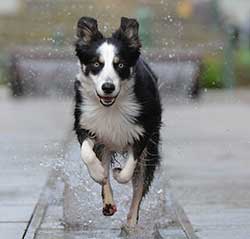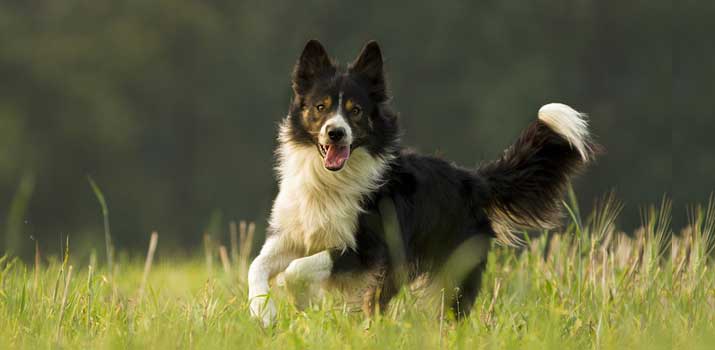Border Collies are remarkable workaholics and loving family pets. Initially, breeders developed these dogs to herd sheep and offer protection to livestock.
Even today, you can find Border Collies diligently working to help ranchers manage daily operations!
All of those functional traits come naturally to this breed.
In many cases, you can see young pups exhibiting protective behaviors at a very young age without any exposure or guidance whatsoever.
Interestingly enough, what makes Border Collies so helpful on a ranch is why people love to care for them as companions.
Loyal and extremely intelligent, they’re eager to learn and become another member of the family.
Pair that with their expressive nature, and you have a lovable friend that will stay by your side through thick and thin!
Because of this breed’s massive popularity, Border Collies are often the subject of scam artists. It’s not uncommon to see unscrupulous breeders trying to pass of mixed breed dogs as purebred Border Collies.
So, how can you tell if a Border Collie is purebred or not?
Whether you’re trying to enter your pooch into a show, participate in breeding programs, or you’re just plain curious, here are some ways you can identify purebred Border Collies.
How to Identify a Border Collie
Breed Weight and Height Standards
One of the first things you should check is how closely your dog meets accepted breed standards.
The American Kennel Club, also known as AKC for short, first recognized the Border Collie breed in 1995. Before that, it occupied the “Miscellaneous Class” of dogs for over five decades.
According to accepted AKC standards, male Border Collies should be between 19 and 22 inches tall at the withers. Female Border Collies are slightly shorter at 18 to 21 inches.
They’re classified as a medium-sized athletic dog that looks muscular yet nimble.
As far as weight goes, the AKC says that the Border Collie should be between 30 and 55 pounds.
The average weight for males is usually around 30 to 45 pounds.
Meanwhile, the average female Border Collie tips the scales at 27 to 42 pounds.
AKC standards are typically used in shows to ensure that dogs are acceptable to qualify in their particular class. However, they can also be used to determine breeding standards.
AKC Appearance Standards
In addition to the weight and height standards, the AKC has some guidelines on what a Border Collie should look like. Now, all dogs are different.
Their appearance depends entirely on genetics. However, breeders use these standards to achieve the “perfect” purebred dog.
Appearance standards can get pretty complex, but here’s some basic information you can use to determine if you have a purebred Border Collie.
Coat Style

All Border Collies have a double coat of fur. On top are the colored layer that you see and touch. Beneath that is a dense layer that the dog uses for insulation.
The double coat is consistent across the breed. However, Border Collies can have one of two coat styles beyond that. The variations are rough and smooth.
Rough Border Collies have noticeably longer fur. The top layer is a bit scraggly. It feels somewhat harsh and covers the body from head to toe.
Smooth Border Collies have shorter fur. It doesn’t hang as low as Rough Collies. Not only that, but the coat is flat, dense, and relatively shiny.
Coat Color
When most people think of a Border Collie, they picture that iconic black and white look. That’s the most prevalent color variety. However, these dogs can have fur in many different hues.
Some varieties include blue, red, sable, lilac, slate, and chocolate.
Many are tricolored or merle-colored. Merle Border Collies have shades of gray, blue, and black, resulting in a mottled effect.
In addition to the color, you can use color markings to identify purebred Border Collies.
These dogs usually have white markings on the feet, legs, and chest. A splash of white appears on the tip of the tail, too.
A blaze marking is common as well. The blaze is a white stripe that runs up the face between the eyes. It’s responsible for the signature mask-like look that Border Collies are known for.
Eye and Tongue Color
The AKC distinguishes specific colors for the eyes and tongue. These colors are supposed to match certain color varieties.
For example, black and white tri-colored Border Collies are supposed to have brown eyes. Meanwhile, Red and white dogs must have yellow or amber-colored eyes.
Blue dogs can have green or amber eyes, while merle Border Collies must have blue eyes.
Tongue color is another indicator. However, this one is a little less reliable. Usually, purebred Border Collies have purple tongues. Spotted appearances exist, too.
Head and Body Features

There are some detailed standards when it comes to head and body shape.
Without getting too deep into the finer details, there are a few telltale signs when trying to spot a purebred.
One of the most reliable is the ears. Border Collies have medium-sized triangle ears. They should stick up partially or all the way.
For partially erect ears, the tips need to fall forward or outward.
As for the body, it’s usually long and well-proportioned. Border Collies aren’t super muscular, but they look lean and fit. The chest is wide and deep as well.
Border Collie Temperament
It’s not just physical features that distinguish purebred Border Collies. Temperament and behavior come into play, too!
As mentioned earlier, Border Collies are extremely intelligent. They pick up on commands relatively quickly and are always eager to learn.
Their brainpower can lead to some issues later on in life. For example, you might see them flexing their intelligence by learning how to open gates or doors!
Border Collies are also energetic. They’re very active and find themselves happiest when given the opportunity to exercise.
In family settings, Border Collies are fiercely loyal. They have protective instincts that translate well to family life.
This breed generally does well in social settings.
Of course, early socialization will come into play. But for the most part, the breed’s working instincts allow it to get along with other dogs, animals, and people.
Border Collie Behaviors
The Border Collie has several distinguishing behaviors that set it apart from others. Here are some of the most telling.
Herding Instincts
Herding is what Border Collies are meant to do!
You can see these instincts in action pretty early on. Even as puppies, these dogs will collect toys and roll balls closely together.
You might see them rounding up leaves or exhibiting some kind of herding behavior in social settings.
If you plan to put the dog to work, it should pick up its duties almost immediately. Border Collies are keen observers that gaze upon flocks of livestock.
When it comes time to herd them, they run in wide loops to direct sheep in the right direction.
Running Style

As they run, there are some behaviors to look out for.
The first is the aforementioned wide paths. These dogs like to run in massive circles even when sheep aren’t involved.
Secondly, they keep their body mass nice and low. The movement helps to maximize speed and agility.
The Signature Gaze
Finally, look out for that signature gaze. Border Collies are keen observers that stare intently at their surroundings. This behavior is easiest to spot in busy environments like the dog park.
Pedigree Information
Any reputable breeder will have some pedigree information. This data forms a documented lineage and family tree.
You should be able to learn more about your dog’s parents, grandparents, and so on.
With enough research, it shouldn’t be too hard to trace your dog’s pedigree all the way back to the original Border Collies!
DNA Testing
If all else fails, you can always invest in a DNA test. DNA tests are available at many vet offices. Alternatively, you can pick up an at-home test. All you need is a saliva swab.
After sending the sample into the lab, you should have results in only a few weeks.
At-home DNA tests are quite reliable and can give you in-depth information about their breed.
Some tests even tell you about your dog’s risk for diseases and genetic disorders.
Conclusion
As long as you love your furry friend, your dog’s purebred status isn’t a huge deal. But, it pays to know the truth. Understanding your dog’s lineage can help you figure out health needs and risks.
Use these tips to figure out if you have a purebred Border Collie.
Also Read: Can German Shepherds Get Along with Cats?


